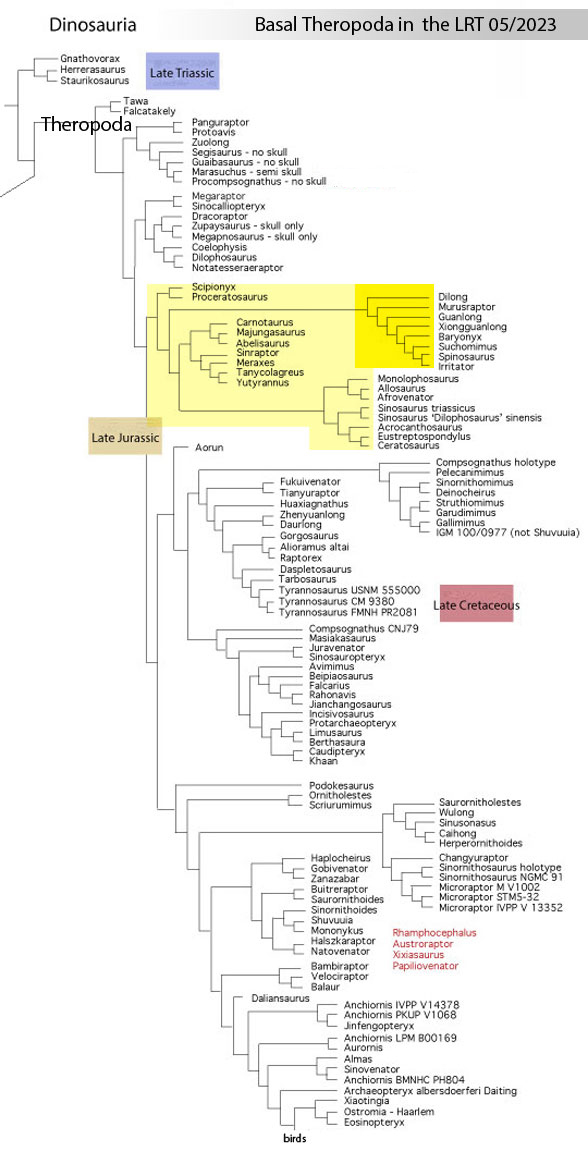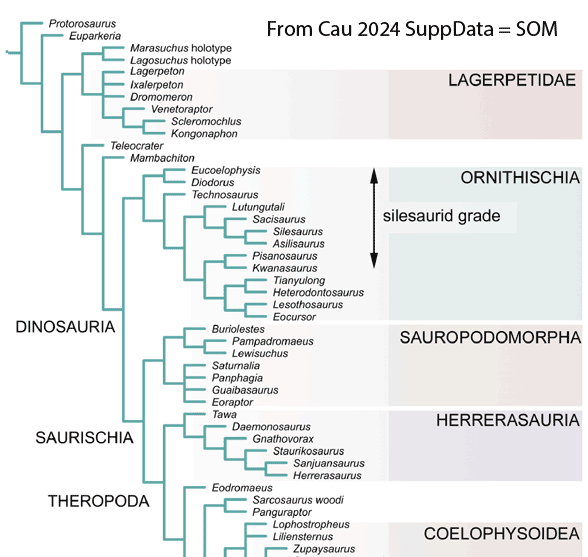Currie and Chen 2001 reported,
“The [smaller] specimens of Sinosauropteryx prima [Fig 1] show skull and orbit proportions, and bone texture typical of immature stages.”
In the LRT juveniles are phylogenetically recovered when these relatively small taxa nest conspicuously among relatively larger-to-much larger taxa. Since extant archosaurs change proportions during ontogenetic growth, similar changes should also be expected in fossil archosaurs. A changing morphology for a single taxon is a taxonomic nightmare. That is why juveniles are generally avoided.
By contrast, pterosaurs and other other lepidosaurs more closely retain adult proportions throughout their growth cycle.That makes ontogeny and phylogeny easier to separate.
Phylogenetic miniaturization is enabled when sexual maturity arrives earlier and earlier. Small precocious parents give rise to small precocious hatchlings in cycle after cycle. Neotony takes over. After several generations immature bone texture will appear in fossils of small, neotonous, yet sexually mature and gravid parents reproducing at a faster rate.

Figure 1. A 3.8m long ‘Sinosauropteryx’ from the FB page of Andrea Cau here compared to smaller specimens of Sinosauropteryx and details for both. Note the manual and pedal difference here. Otherwise the large and small specimens score so closely that they nest together in the LRT.
On his Facebook page,
Andrea Cau published a photo of an undescribed 3.8m long Sinosauropteryx. After testing in the LRT this specimen indeed nests with the smaller specimens. According to Cau’s caption: “This is the so-far-undescribed “largest Sinosauropteryx”, an amazing 3.8 m long (!) specimen housed in a Chinese museum and claimed to be a Sinosauropteryx. Although not yet included in my matrix, this specimen confirms the hypothesis developed in my latest paper that “compsognathids” are not adult morphs of small size, but juvenile semaphoronts of larger tetanurans. This specimen would surely improve the systematic placement of the Jehol Biota “compys”.
Sinosauropteryx 3.8m specimen
(not yet described; Early Cretaceous, Yixian Formation). The hand and foot are distinct from the holotype (Fig 1). The tail is relatively shorter. The hind limb is relatively longer, more typical of theropod proportions. The premaxilla is robust with hyper-robust premaxillary teeth. The anterior dentary tooth is a fang. Otherwise, scores in the LRT are very similar.

Figure 2. The 3.8 Sinosauropteryx specimen compared to related taxa, including Aorun, Compsognathus and the holoype Sinosauropteryx.
Here’s a pair of questions for all you lumpers and splitters out there:
At what point do you ascribe ontogeny to similar, yet distinct fossil archosaurs?
At what do you ascribe phylogeny to similar, yet distinct fossil archosaurs?
Let’s remember, juvenile flamingos have short legs and juvenile alligators have a shorter rostrum than adults do. In Sinosauropteryx the torso and tail length vary. So do the phalangeal proportions. The skull is nearly the same except for the gracile-robust difference. The two small skulls (Fig 1) also show individual differences.
The LRT currently tests several juveniles among the two thousand adults.. Small taxa often accumulate as examples of phylogenetic miniaturization at the bases of new clades. Traditionally these tiny adults have been omitted from analyses – if they are pterosaurs – but not omitted if they are mammals.
In the LRT ontogeny-phylogeny problems are handled by specimen numbers or other identifiers (like ‘3.8m’). So no special coding is necessary.
Currie and Chen 2001 reported on the smaller specimens.
“Sinosauropteryx prima has a number of characters that were poorly preserved in known specimens of the closely related Compsognathus longipes from Europe. These include the longest tail known for any theropod and a three-fingered hand dominated by the first digit, which is longer and thicker than either of the bones of the forearm.” (Fig 1).
“Sinosauropteryx is comparable in size and morphology to known specimens of Compsognathus (Bidar et al. 1972; Ostrom 1978) from Europe. Sinosauropteryx and Compsognathus share a suite of characters that indicate close relationship.” (Fig 2).

Figure 3. From 2023, the theropod subset of the LRT.
Sinosauropteryx prima (smaller specimens)
(Ji and Ji 1996; Currie and Chen 2001, Early Cretaceous, Yixian Formation, Fig 1) is considered to have very primitive feathers. The rostrum is relatively short. The dorsal vertebrae are robust. The tail is quite long and gracile. The humerus is short and robust. The elbow (ulna) and manual digit 1 are both robust. The hind limbs are relatively shorter and robust.

Figure 4. Portion of a cladogram from Cau 2024 SuppData (SOM). Second frame indicates clades in the LRT. One of these two is a little shuffled due to taxon excluion and other factors. Cau includes many taxa known from scraps that do not appear in the LRT.
Cau reported on his phylogenetic analysis:
“A detailed description of the result of the phylogenetic analysis based on the OSP data set is beyond the aims of this contribution. Here, I briefly mention the most significant
elements of the topology reconstructed, and discuss in detail the affinities of the compsognathid-like OTUs. The analysis found 10000 shortest trees.”
That’s a huge number when only one shortest tree is the goal. Systematists try to model actual evolutionary events and this should lead to a single tree. In my experience omitting scrappy taxa helps facilitate resolution. Cau includes scrappy taxa. There’s a time and place for that This might not be that time and place as Cau concurs in the next paragraph.
“The reduced consensus tree after the pruning of the less stable “wildcard” OTUs is well-resolved and supports the monophyly of successively less inclusive subgroups of the avian totalgroup e.g., Dinosauria, Saurischia, Theropoda, Averostra, Tetanurae, Neotetanurae,
Coelurosauria, Maniraptoriformes, Maniraptora, Paraves and Avialae. Most of the “wilcards” [sic] are taxa known uniquely for immature semaphoronts and thus
could not be directly compared to the majority of OTUs (which are known uniquely for mature semaphoronts).”
As mentioned yesterday, Cau’s outgroups (Fig 4) were traditional and cherry-picked, not the result of testing with the inclusion of pertinent taxa. Missing is a long list of poposaurs and basal bipedal crocodylomorphs. These are both proximal outgroups to the Dinosauria in the LRT. Unrelated taxa (e.g. the bipedal proterochampsid Lagerpeton) are not appropriate here. As a result, Cau did not find a basal split in the Dinosauria separating Theropoda from Phytodinosauria, as in the LRT.
Cau provided no reconstructions with DGS colors (Fig 1) for readers to see how scores were rendered. So scoring may also be an issue. Cau did not recognize phylogenetic miniaturization and neotony as a method used by nature to accelerate reproduction and introduce new morphologies in smaller taxa.
Cau’s analysis found
Aorun (Fig 2) an early diverging member of the Allosauroidea. That is confirmed by the LRT (Fig 3) where that divergence made Aorun basal to a long list of descendant theropods, including compsognathids and their descendants on one branch. Podokesaurus, Ornitholestes and their descendants, including birds, are at the base of the other branch following Aorun.
Here’s a TED Talk YouTube video featuring Jack Horner
on shape-shifting dinosaurs. Like I said, these can be taxonomic nightmares.
Bottom line:
The large and small Sinosauropteryx specimens (Fig 1) do nest together in the LRT. They have nearly identical skulls, except for the increase in robust characters in the large one. The torso and tail have different proportions. The feet have longer toes on one vs the other. The hands are very different. If those differences are acceptable to you as part of the growing-process (allometry), then meet the Sinosauropteryx family. If not acceptable, and you understand the process of phylogenetic miniaturization, then the small and large specimens are more distant cousins, different species. Even so, no other taxa are closer to either one than they are to each other in the LRT.
Cau needed to test a larger number of more complete taxa and omit (at least until later) the many scrappy taxa that score too few traits to be useful on this topic.
References
Cau A 2024. A Unified Framework for Predatory Dinosaur Macroevolution. Bollettino della Società Paleontologica Italiana, 63(1): 1-19.
Currie PJ and Chen PJ 2001. Anatomy of Sinosauropteryx prima from Liaoning, northeastern China. Canadian Journal of Earth Sciences, 38: 705-727.
Ji Q and Ji S-A 1996. On the Discovery of the earliest fossil bird in China (Sinosauropteryx gen. nov.) and the origin of birds. Chinese Geology 233:30-33.

Hey Peters,
In this article you bring up the point that you exclude scrappy taxa and that Cau shouldn’t have. I personally believe that the exclusion of scrappy taxa is actually a problem depending on how scrappy it is. If it’s a few teeth or just a vertebra then I can understand that but the exclusion of more relatively complete scrappy taxa is detrimental to the understanding of a grouping. Take for instance the LRT. The lack of somewhat scrappy taxa and a lot of mostly complete taxa makes it feel like the tree would resemble more of what the scientific consensus is. For instance there is one representative of Pachycephalosauria which I get that the genus picked out, Stegoceras, is the most complete Pachycephalosaur but the exclusion of some other rather complete Pachycephalosaurs (e.g. Pachycephalosaurus, Homalocephale) makes it feel like the placement would be different if those taxa were included. Same goes for Oviraptorosauria and Therizinosauroidea. There is only a few representative of these groups. Then there’s also the exclusion of a lot of ceratopsians which while there are quite a few that you did test, it doesn’t really encompass the diversity of Ceratopsia with the placement of certain taxa most likely changing if more basal were tested as well as later ceratopsians. This same point goes for Ankylosauria, Stegosauria, Hadrosauroidea, Sauropoda, etc. etc. Though I do get that testing taxa takes a long time to do and it does make sense why you only went with specific taxa for each broad grouping of Dinosauria but that exclusion does make it feel like if more intermediate taxa and other taxa were included, the tree would change in unexpected ways.
From, Stu
Thanks Stu, I think you’ve understood the problem and its solution in your comment. re: the scientific consensus… sometimes that needs an update. Individuals provide that update. Those updates take time to filter through the community, which would (for the most part) rather not tell their students their expensive textbooks are out of date. So their lectures follow the textbooks and you can see how that stalls progress. I’ve seen a video where Dr Unwin tells his class, “We don’t know where pterosaurs come from. Well, there is one person who says he knows, but I don’t see him here today.” That’s the first step in this thing we call progress. You have to be patient in paleontology.